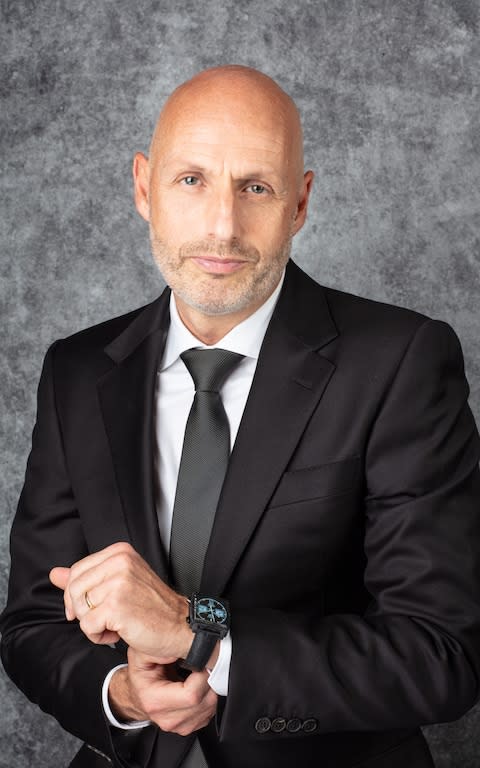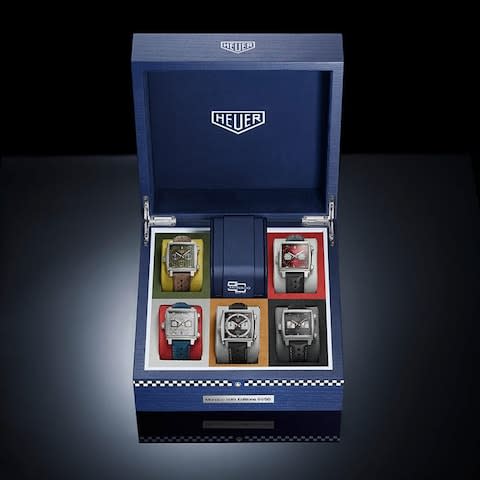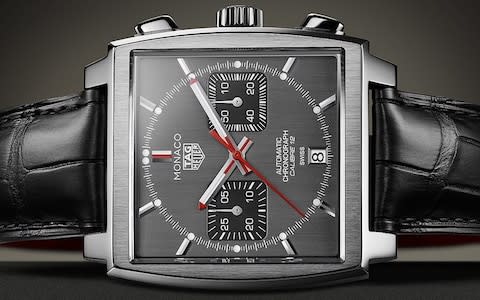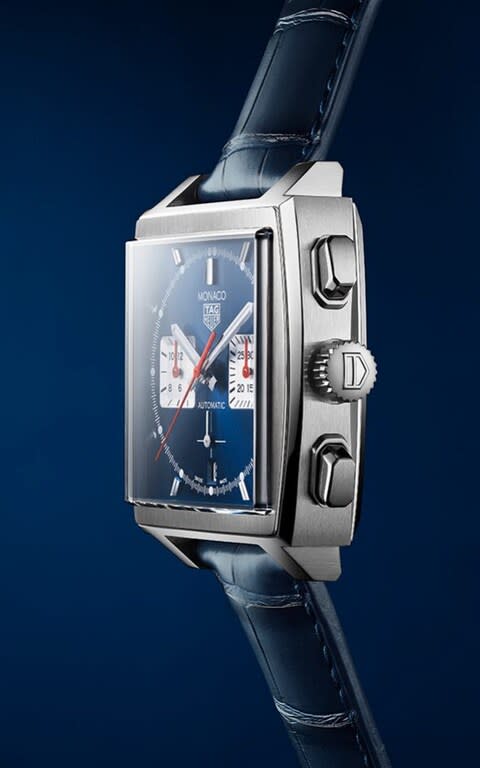Steve McQueen and how the TAG Heuer Monaco watch became a fast-paced icon
The story is the stuff of marketing legend: Introduced in 1969 as a tribute to the world’s most famous Grand Prix, the Heuer Monaco hit the pinnacle of cool in 1971 when actor Steve McQueen chose to wear the watch in the movie Le Mans.
Mentored for the role by real-life racing driver, Jo Siffert, McQueen asked to borrow Siffert’s racing suit which featured the orange and blue livery of sponsor Gulf Oil plus an embroidered ‘Chronograph Heuer’ crest. To complete the look, McQueen also decided to wear the Calibre 12 Monaco. The rest is history.
Large and square, the Monaco has never been TAG Heuer’s biggest seller, yet its significance to the brand is beyond question. Thanks to some clever, yet uncontrived, product placement in Le Mans (1971), the model has secured a seat in horology’s Hall of Fame as one of the most famous motor-racing chronographs of all time.
Fast-forward 50 years and TAG Heuer – as the company has been known since 1985 – has a shiny new CEO. When Stéphane Bianchi took the helm a year ago, no one was more surprised than him. He had left the Yves Rocher Group in 2015 after 20 years, with the intention of buying his own company.

"I love to work for a family-owned companies," he says. "And, although I did not intend to work for a group, this offer was too good to pass up. A week after leaving Yves Rocher, I got a call from Mr Arnault [chairman of TAG Heuer’s owner LVMH Group]. I met with him and I told him my story and that I was looking to have a rest from work."
After that the two men met regularly with Arnault eventually asking Bianchi to take over the LVMH watch division, consisting of Zenith, Hublot and TAG Heuer. A big watch fan, as well as a car lover, Bianchi’s interest was piqued and LVMH watches had a new boss. "And you know what?" Bianchi says. "I don't feel like I’ve lost anything by the company not being mine, I'm very happy to work again with a great team."
Coming into TAG Heuer at the start of a big anniversary for a signature watch could have been daunting, but for Bianchi the challenge of celebrating 50 years of the lauded Monaco is one that he accepted with relish. "I knew Le Mans, I love the Porsche 917 and I actually bought a Monaco for myself about 15 years ago. I was excited to find new ways to celebrate the half-century of this icon."
The celebrations have been many and global. Starting at its namesake Monaco Grand Prix in May, the first of five celebratory models was released, each one recognising a decade since its creation. This was followed by Le Mans in June, New York in July, Japan in September and Shanghai in October. All of the watches were made in a limited edition of 169 pieces and each sold like hot cakes.

On why the edition numbers were so low, Bianchi says that the aim was not to make money, but rather to reward existing collectors with something special. In addition to the individual pieces, there were also 50 box sets made containing all five watches and these sold out even more rapidly – the UK’s allocation going in just three minutes.
"Every decade was represented by a design specific to the era," says Bianchi. "It may be a 50-year-old watch, but it's still a contemporary design. Even in China where the Monaco has not traditionally sold well, the new generation is appreciating the very specific aesthetic."
But, despite their success, the five special editions were just the prelude to a bigger surprise that was revealed in London in early-November when two final anniversary pieces were unveiled: one a limited edition of 1,000, housing the final Calibre 12 movements that will be used in a Monaco, the other housing a new generation Heuer 02 in-house movement specially adapted for the square-cased watch.
Calibre 12, introduced shortly after the Monaco’s release, was an evolution of the famed Calibre 11 self-winding chronograph from 1969 and, unlike its predecessor, it had its winding crown on the right of the case. It is a modular movement with the chronograph component on top if the base calibre and, for that reason, the crown sits slightly lower than the chronograph pushers. "This is definitely the end for Calibre 12," Bianchi says. "I know we could have made more but this farewell has to be special and even 1,000 pieces is quite a large run for collectors."

Slimmer than the Calibre 11 and 12 movements, the Heuer 02 has twice the power reserve of both Calibre 11 and 12 at 80 hours. And, because it is a fully integrated movement, the crown and pushers are all on the same side of the case, and in perfect alignment.
But purists need not worry. As TAG Heuer says farewell to the Calibre 12, the Calibre 11 with crown on the left of the case will stay in the collection. Other differences will include a solid caseback for Calibre 11 and an exhibition one for Heuer 02. In terms of price, the difference will be minimal. So, the choice is simple – the OG Calibre 11 or the slick and forward-looking Heuer 02.

For now, the case thickness of the Heuer 02 version stays the same, but in the future, who knows. The innovative nature of the Monaco has already lent itself to adaptations such as the hybrid Monaco Sixty-Nine from 2003, 2004’s belt-driven V4, 2006’s 360 LS (Linear Second)with 1/100th of a second chronograph and the high-frequency Monaco Twenty-Four Concept Chronograph from 2009.
"The concepts are a way for us to say, "Hey, it's an icon, but it can still be very modern"," says Bianchi. "At TAG Heuer, we have our Institute, where 20-odd scientists are working on concepts to improve accuracy and precision and, for sure, we will see more concepts revealed in the Monaco case."
With a laboratory to make any scientist green with envy, the TAG Heuer Institute is a first for a watch company and an asset that Bianchi calls "crazy". But then TAG Heuer can be crazy. Just look at the Monaco – a watch that takes avant-garde to new heights. "Yes," says Bianchi. "But when you’re speaking about the Monaco, you're speaking about the whole brand."
Sign up for the Telegraph Luxury newsletter for your weekly dose of exquisite taste and expert opinion.

 Yahoo Finance
Yahoo Finance 